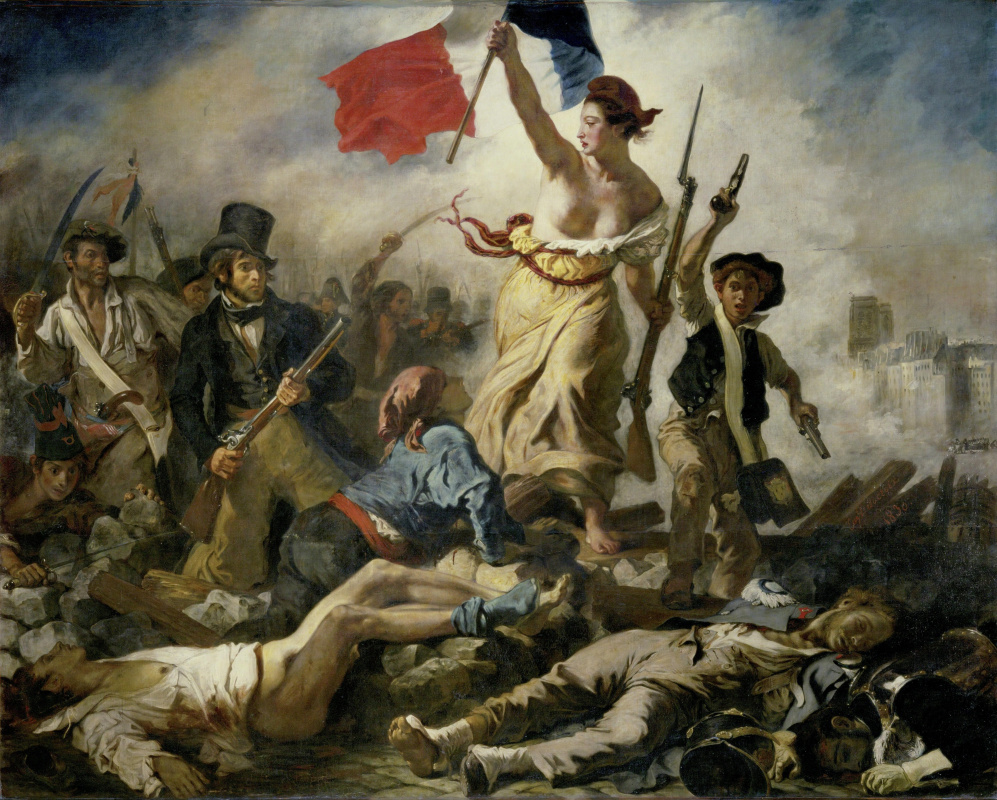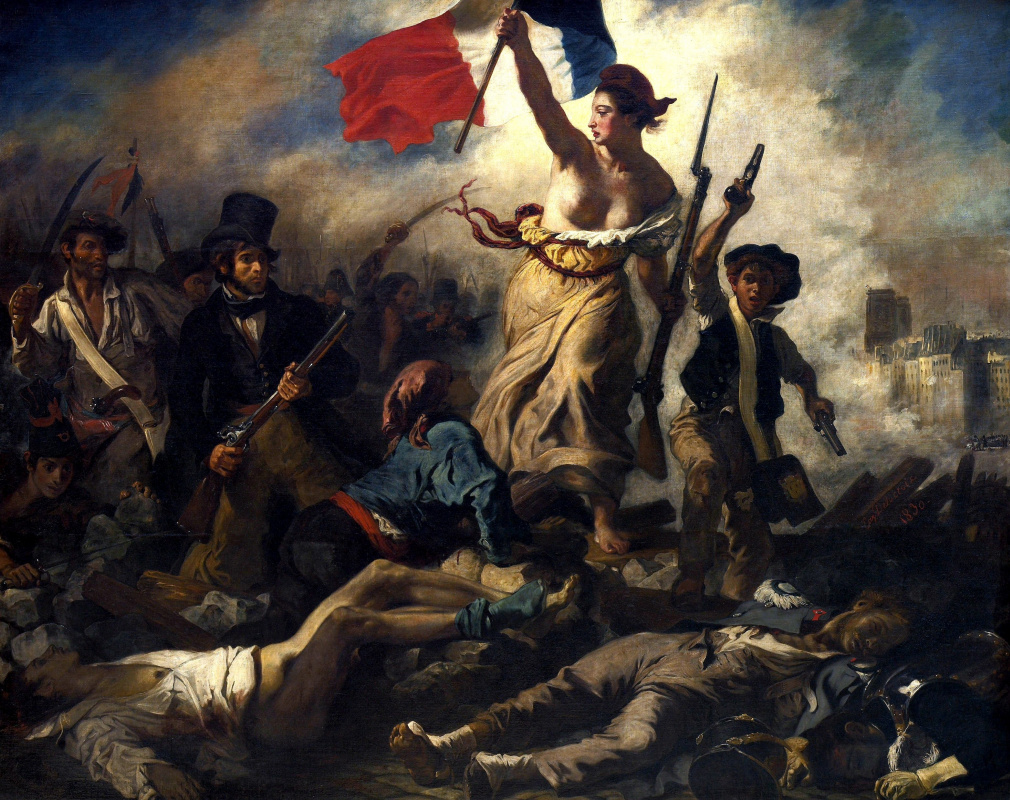log in
Enter site
Login to use Arthive functionality to the maximum
Liberty leading the people
Eugene Delacroix • 绘画, 1830, 260×325 厘米
画作描述 «Liberty leading the people»
Topless girl with the profile of a Greek goddess and the living, warm body with a French tricolor and a rifle in his hands is strongly associated with the vague concept of "freedom" for nearly two centuries. This image used by cartoonists depicting bureaucratic vices, it was used in the French flyers during the Second world war. This image literally materialized, when in 1968 on the cover of the news magazine Paris Match there was a picture student Caroline de Bendern.
Publishing news on the student unrest of 1968, grew into a multimillion-dollar strike and political upheaval, the entire world logs multiply photo Carolyn, creating a new media image of freedom. This image has become strong and effective only because very emotionally resonated with the painting of Delacroix.
Eugene Delacroix painting called "28 July, 1830". These figures were enough to French audience understood and remembered particular day, bloody and terrible, who inspired and gave hope.
On this day in Paris mutiny, which would later be called the July revolution and which led to a change of government and political regime. It would seem that it was started by wretched: one king changed to another. Charles X, a staunch conservative, came to power in 1824, and in 6 years rule gradually destroyed all the institutions and the laws enacted under Napoleon. The flag was facing the death penalty, for example. When in 1830 the government passed a number of decrees restricting freedom of speech and dissolve the House of representatives, the French remembered that the barricades – this is the only proven way to Express dissatisfaction. Members of the government were arrested, the king abdicated and left the Kingdom.
Eugene Delacroix, the son of a former foreign Minister under Napoleon, was not on the barricades, but was an enthusiastic spectator." "I chose a contemporary story – of the barricades. And since I haven't fought for my country, I write in her honor", - according to the artist's brother. The painting measuring three by two and a half meters Delacroix will write in just three months. It works fast and enthusiastically, leaving a wide sweeping strokes, and even your own experiences, transforming their mood in a unique manner.
This is the first painting by Delacroix, which depicts his contemporaries and friends, a specific event. Red, white and blue, reflected from the tri-color flag of Liberty, can be heard on all the tracks. Loved all the romance the corpses in the foreground doesn't look much like the bodies of the fallen heroes. And over still living rebels can confidently judge about their recent participation in the looting: on the boys shoulder and work to take the same bags with ammunition, and it bags of the Royal soldiers. The body of a man without pants in the foreground, persuades us to doubt the morals of the rebels – his trousers stolen course.
And despite that the film "28 July, 1830" has managed to become a symbol not only of revolution, but of the whole of France and freedom in General. St. Petersburg art critic Ilya Doronchenkov argues that from the time of early Christianity when the abstract values embodied in the life of Christ, to Delacroix nobody has been able to create such a real and full-blooded character of abstract concepts. The concept of freedom.
The state bought the painting as soon as it was presented at the Salon of 1831, but only after 43 years it took from the dark corridors of the Palace and placed on the wall of the Louvre for all to see. Each government, different ways of coming to power in France, considered it too dangerous.
Author: Anna Sidelnikova
Publishing news on the student unrest of 1968, grew into a multimillion-dollar strike and political upheaval, the entire world logs multiply photo Carolyn, creating a new media image of freedom. This image has become strong and effective only because very emotionally resonated with the painting of Delacroix.
Eugene Delacroix painting called "28 July, 1830". These figures were enough to French audience understood and remembered particular day, bloody and terrible, who inspired and gave hope.
On this day in Paris mutiny, which would later be called the July revolution and which led to a change of government and political regime. It would seem that it was started by wretched: one king changed to another. Charles X, a staunch conservative, came to power in 1824, and in 6 years rule gradually destroyed all the institutions and the laws enacted under Napoleon. The flag was facing the death penalty, for example. When in 1830 the government passed a number of decrees restricting freedom of speech and dissolve the House of representatives, the French remembered that the barricades – this is the only proven way to Express dissatisfaction. Members of the government were arrested, the king abdicated and left the Kingdom.
Eugene Delacroix, the son of a former foreign Minister under Napoleon, was not on the barricades, but was an enthusiastic spectator." "I chose a contemporary story – of the barricades. And since I haven't fought for my country, I write in her honor", - according to the artist's brother. The painting measuring three by two and a half meters Delacroix will write in just three months. It works fast and enthusiastically, leaving a wide sweeping strokes, and even your own experiences, transforming their mood in a unique manner.
This is the first painting by Delacroix, which depicts his contemporaries and friends, a specific event. Red, white and blue, reflected from the tri-color flag of Liberty, can be heard on all the tracks. Loved all the romance the corpses in the foreground doesn't look much like the bodies of the fallen heroes. And over still living rebels can confidently judge about their recent participation in the looting: on the boys shoulder and work to take the same bags with ammunition, and it bags of the Royal soldiers. The body of a man without pants in the foreground, persuades us to doubt the morals of the rebels – his trousers stolen course.
And despite that the film "28 July, 1830" has managed to become a symbol not only of revolution, but of the whole of France and freedom in General. St. Petersburg art critic Ilya Doronchenkov argues that from the time of early Christianity when the abstract values embodied in the life of Christ, to Delacroix nobody has been able to create such a real and full-blooded character of abstract concepts. The concept of freedom.
The state bought the painting as soon as it was presented at the Salon of 1831, but only after 43 years it took from the dark corridors of the Palace and placed on the wall of the Louvre for all to see. Each government, different ways of coming to power in France, considered it too dangerous.
Author: Anna Sidelnikova



